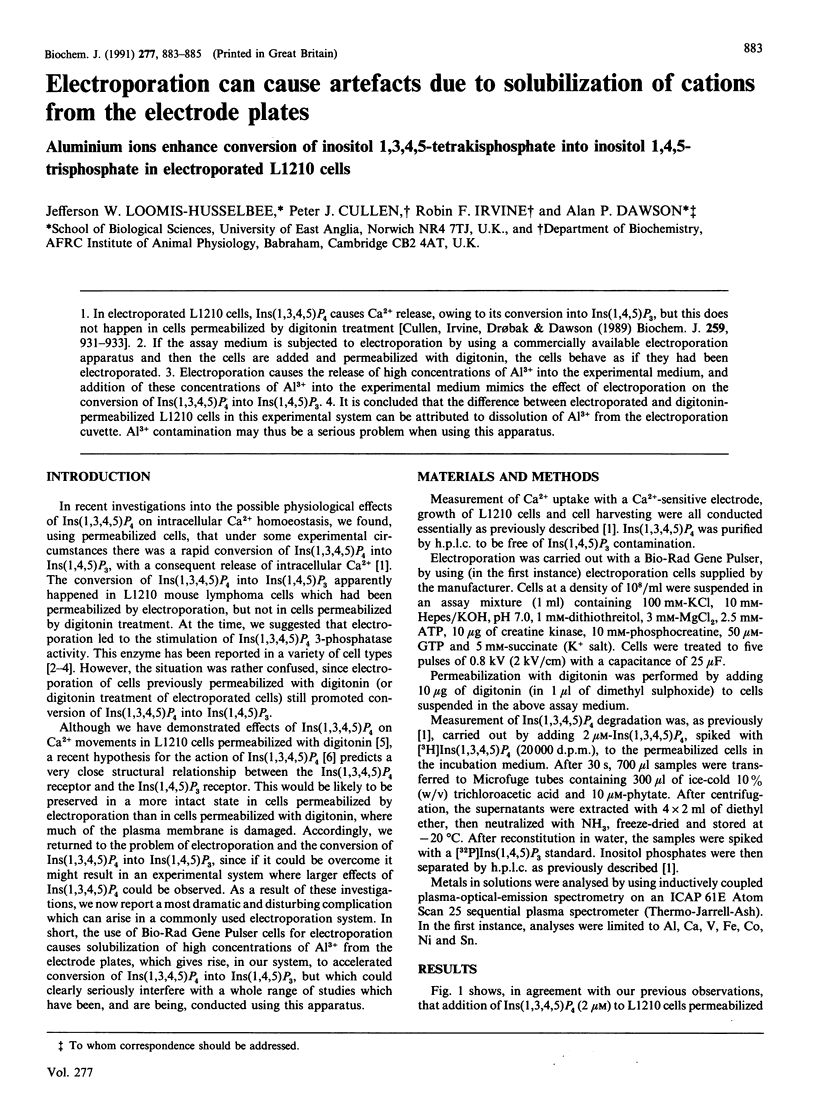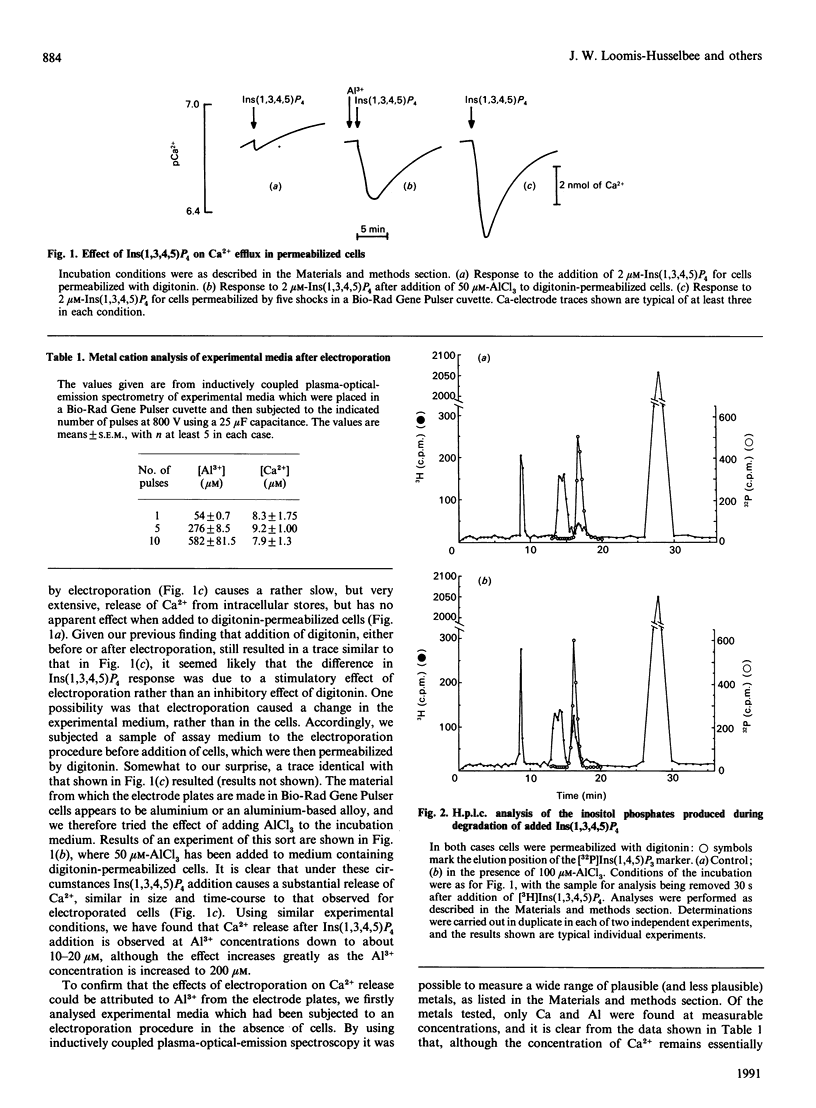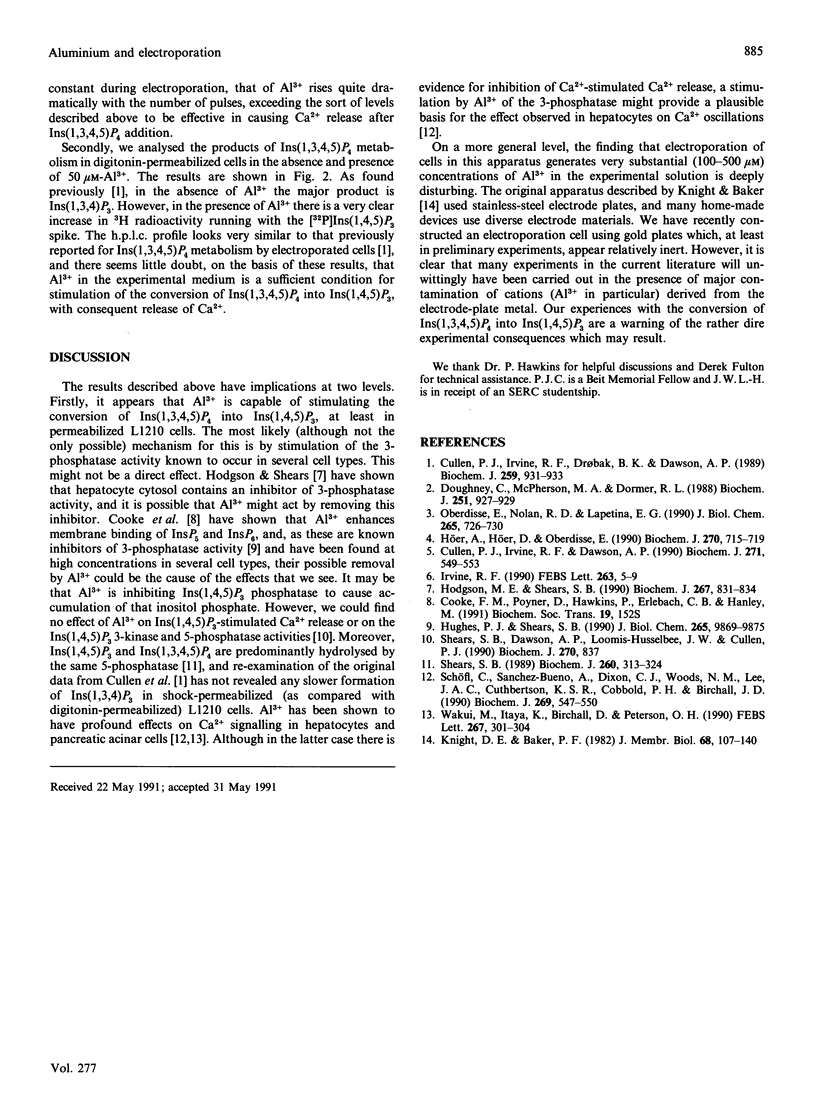Abstract
1. In electroporated L1210 cells, Ins(1,3,4,5)P4 causes Ca2+ release, owing to its conversion into Ins(1,4,5)P3, but this does not happen in cells permeabilized by digitonin treatment [Cullen, Irvine, Drøbak & Dawson (1989) Biochem. J. 259, 931-933]. 2. If the assay medium is subjected to electroporation by using a commercially available electroporation apparatus and then the cells are added and permeabilized with digitonin, the cells behave as if they had been electroporated. 3. Electroporation causes the release of high concentrations of Al3+ into the experimental medium, and addition of these concentrations of Al3+ into the experimental medium mimics the effect of electroporation on the conversion of Ins(1,3,4,5)P4 into Ins(1,4,5)P3. 4. It is concluded that the difference between electroporated and digitonin-permeabilized L1210 cells in this experimental system can be attributed to dissolution of Al3+ from the electroporation cuvette. Al3+ contamination may thus be a serious problem when using this apparatus.
Full text
PDF


Selected References
These references are in PubMed. This may not be the complete list of references from this article.
- Cooke F., Poyner D., Hawkins P., Erlebach C. B., Hanley M. Inositol hexakisphosphate-membranes interactions: the role of metal ions. Biochem Soc Trans. 1991 Apr;19(2):152S–152S. doi: 10.1042/bst019152s. [DOI] [PubMed] [Google Scholar]
- Cullen P. J., Irvine R. F., Dawson A. P. Synergistic control of Ca2+ mobilization in permeabilized mouse L1210 lymphoma cells by inositol 2,4,5-trisphosphate and inositol 1,3,4,5-tetrakisphosphate. Biochem J. 1990 Oct 15;271(2):549–553. doi: 10.1042/bj2710549. [DOI] [PMC free article] [PubMed] [Google Scholar]
- Cullen P. J., Irvine R. F., Drøbak B. K., Dawson A. P. Inositol 1,3,4,5-tetrakisphosphate causes release of Ca2+ from permeabilized mouse lymphoma L1210 cells by its conversion into inositol 1,4,5-trisphosphate. Biochem J. 1989 May 1;259(3):931–933. doi: 10.1042/bj2590931. [DOI] [PMC free article] [PubMed] [Google Scholar]
- Doughney C., McPherson M. A., Dormer R. L. Metabolism of inositol 1,3,4,5-tetrakisphosphate by human erythrocyte membranes. A new mechanism for the formation of inositol 1,4,5-trisphosphate. Biochem J. 1988 May 1;251(3):927–929. doi: 10.1042/bj2510927. [DOI] [PMC free article] [PubMed] [Google Scholar]
- Hodgson M. E., Shears S. B. Rat liver contains a potent endogenous inhibitor of inositol 1,3,4,5-tetrakisphosphate 3-phosphatase. Biochem J. 1990 May 1;267(3):831–834. doi: 10.1042/bj2670831. [DOI] [PMC free article] [PubMed] [Google Scholar]
- Hughes P. J., Shears S. B. Inositol 1,3,4,5,6-pentakisphosphate and inositol hexakisphosphate inhibit inositol-1,3,4,5-tetrakisphosphate 3-phosphatase in rat parotid glands. J Biol Chem. 1990 Jun 15;265(17):9869–9875. [PubMed] [Google Scholar]
- Höer A., Höer D., Oberdisse E. Properties of a soluble inositol 1,3,4,5-tetrakisphosphate 3-phosphatase from porcine brain. Biochem J. 1990 Sep 15;270(3):715–719. doi: 10.1042/bj2700715. [DOI] [PMC free article] [PubMed] [Google Scholar]
- Irvine R. F. 'Quantal' Ca2+ release and the control of Ca2+ entry by inositol phosphates--a possible mechanism. FEBS Lett. 1990 Apr 9;263(1):5–9. doi: 10.1016/0014-5793(90)80692-c. [DOI] [PubMed] [Google Scholar]
- Knight D. E., Baker P. F. Calcium-dependence of catecholamine release from bovine adrenal medullary cells after exposure to intense electric fields. J Membr Biol. 1982;68(2):107–140. doi: 10.1007/BF01872259. [DOI] [PubMed] [Google Scholar]
- Oberdisse E., Nolan R. D., Lapetina E. G. Thrombin and phorbol ester stimulate inositol 1,3,4,5-tetrakisphosphate 3-phosphomonoesterase in human platelets. J Biol Chem. 1990 Jan 15;265(2):726–730. [PubMed] [Google Scholar]
- Schöfl C., Sanchez-Bueno A., Dixon C. J., Woods N. M., Lee J. A., Cuthbertson K. S., Cobbold P. H., Birchall J. D. Aluminium perturbs oscillatory phosphoinositide-mediated calcium signalling in hormone-stimulated hepatocytes. Biochem J. 1990 Jul 15;269(2):547–550. doi: 10.1042/bj2690547. [DOI] [PMC free article] [PubMed] [Google Scholar]
- Shears S. B., Dawson A. P., Loomis-Husselbee J. W., Cullen P. J. The perturbation, by aluminium, of receptor-generated calcium transients in hepatocytes is not due to effects of Ins(1,4,5)P3-stimulated Ca2+ release or Ins(1,4,5)P3 metabolism by the 5-phosphatase and 3-kinase. Biochem J. 1990 Sep 15;270(3):837–837. doi: 10.1042/bj2700837a. [DOI] [PMC free article] [PubMed] [Google Scholar]
- Shears S. B. Metabolism of the inositol phosphates produced upon receptor activation. Biochem J. 1989 Jun 1;260(2):313–324. doi: 10.1042/bj2600313. [DOI] [PMC free article] [PubMed] [Google Scholar]
- Wakui M., Itaya K., Birchall D., Petersen O. H. Intracellular aluminium inhibits acetylcholine- and caffeine-evoked Ca2+ mobilization. FEBS Lett. 1990 Jul 16;267(2):301–304. doi: 10.1016/0014-5793(90)80949-j. [DOI] [PubMed] [Google Scholar]


